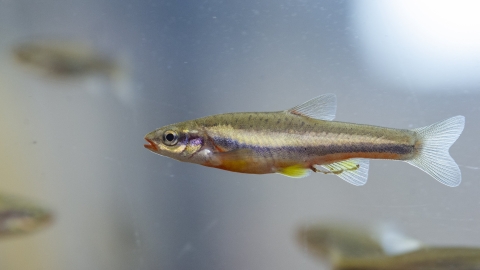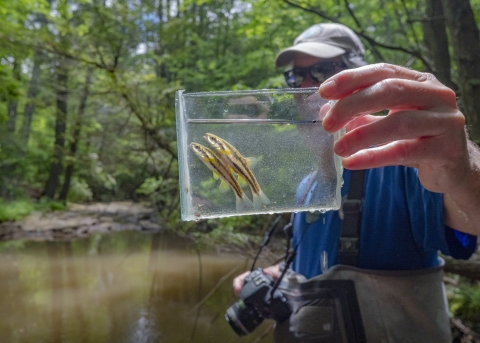An underwater rainforest - overflowing with an array of animals and plants of various shapes, sizes and colors. That’s how Dr. Anna George, the Tennessee Aquarium’s vice president of Conservation Science and Education, describes the rivers and streams of the Southeast United States.
“There are so many kinds of creatures living in the rivers and streams,” George says. “You may not have heard or them or might not know they are there, but they are wonderful, they are beautiful, and they are part of what makes the Southeast special.”
The headwaters of Tennessee are no exception. Among the mussels, crawfish, and other aquatic life swims one of North America’s most endangered fish – the laurel dace.
At barely two and a half inches long, this little fish faces a giant fight as it battles for its continued existence.
First collected in 1976 at Waldon Ridge, the laurel dace wasn’t described as its own species until 2001. At the time, it was known to inhabit six streams in the Waldon Ridge and Sequatchie River Valley portions of the Cumberland Plateau. Historical records indicate a seventh stream was also home to the fish at one time.
The U.S. Fish and Wildlife Service listed the species as endangered under the Endangered Species Act (ESA) in 2011.
Even with the protections of the ESA, the population continues to fall. Only portions of four streams are known to have active laurel dace populations today.
What’s causing the fish to disappear? Poor water quality from sedimentation, and predation from non-native species.
Most of the habitat of the laurel dace is surrounded by farms. To grow vegetables, many farming practices use a layer of plastic placed over the crops, creating an impervious surface. When it rains, water can’t soak into the ground. Rather, it runs off into nearby waterways carrying soil, herbicides and pesticides which compromises the streams the laurel dace once thrived in.
Additionally, heavy rains flood farm ponds that are often stocked with sunfish and bass. As the flood waters flow over the dam, they carry these non-native predatory fish with them. As these fish don’t naturally occur in the streams, the laurel dace quickly become a food source and struggle to survive.
“From a scientific point of view, we’re pulling our hair out. This fish is disappearing,” says Bernie Kuhajda, Tennessee Aquarium Conservation Institute (TNACI) Aquatic Conservation Biologist “What are we going to do to help the laurel dace, but still allow farming, in a more responsible way.”
Conservationists realized they had to start at the source by improving the quality of headwater streams.
“We have to restore habitat where we lost the laurel dace,” says George. “If you mess up the headwater streams, that pollution is carried downstream to much bigger rivers. You can't fix it later on, so you've got to start on the ridge."
Thus, the Ridges to Rivers program was born.
Ridges to Rivers
Ridges to Rivers is led by TNACI. It aims to improve water quality in the Sequatchie River Valley and Walden Ridge areas by partnering with farmers to implement farming practices that benefit both the landowner and environment.
Over the next five years, TNACI will help distribute $10 million to landowners through a Natural Resource Conservation Service grant to drive Ridges to Rivers forward.
Seven million dollars will be used over five years to target habitat improvement for the laurel dace. Other federally listed threatened and endangered species will benefit from these efforts too, including the sickle darter, slabside pearlymussel, Anthony’s riversnail, royal marstonia, and many more.
A few of the best management practices that will be employed in this program include:
Planting critical areas in swales and high erosion areas to diminish stormwater runoff
Creating barriers to prevent fish from swimming over pond dams when water overflows
Planting “filter strips” along streams or fields to decrease erosion by slowing rainwater before it enters waterways
Planting winter cover crops to reduce soil erosion in the rainy season and improve soil health
A goal for this program is that as farmers join, their neighbors will see the success and want to join too.
Implementing these practices on farms will improve soil health and retention while using fewer herbicides, pesticides, and fertilizers. In turn, these practices should help farmers make a little more money while helping nature.
Is there hope for recovery?
“To work with endangered species, you can’t be a pessimist!” says Kuhajda.
The collaborative and innovative nature of the Ridges to Rivers Program brings a positive outlook for the laurel dace and its habitat.
“It's not just the folks living next to the laurel dace that we depend on for protection. It’s all of us working together as part of this watershed community that can really make a difference in having healthy streams for all of these animals,” says George. “Keeping them safe means keeping safe water for all of us to enjoy.”
Kuhajda echoes her sentiment: “Even if you don’t live in the very small area where laurel dace is found, you’re human, you drink water. You’re a human. There’s a likelihood you play in water somewhere – kayaking, fishing, paddleboarding – so you really should care about clean water.”
He adds, “Anything you do on a ridge ends up in a river.”
While the Ridges to Rivers program is a community effort to protect the laurel dace, George also has hope for the species’ recovery under the ESA. After all, as she puts it, the ESA protections are what opened the door to allow for funding of Ridges to Rivers in the first place.
“I have a lot of hope in how the Endangered Species Act has prevented extinction for many different species,” she says. “As long as we have a strong ESA in place, I have a lot of hope for recovery for the species.”
Currently, the ESA protects 1,662 U.S. species and 638 foreign species. With ongoing threats such as habitat loss and new threats like climate change climate change
Climate change includes both global warming driven by human-induced emissions of greenhouse gases and the resulting large-scale shifts in weather patterns. Though there have been previous periods of climatic change, since the mid-20th century humans have had an unprecedented impact on Earth's climate system and caused change on a global scale.
Learn more about climate change , a commitment to species conservation and the ESA continues to be vital. In every state across the country, there are Service staff and partners working to conserve endangered species and the habitat they depend on. It’s up to all of us to continue the success of the ESA and ensure future generations can experience the natural heritage we all cherish.
To learn more about Ridges to Rivers, visit: Working with farmers to save one of America's most-endangered fish - YouTube
*When you use the video link, you are leaving the USFWS website. DOI and the bureaus do not guarantee that outside websites comply with Section 508 (Accessibility Requirements) of the Rehabilitation Act. Links also do not constitute endorsement, recommendation, or favoring by the U.S. Fish and Wildlife Service.






